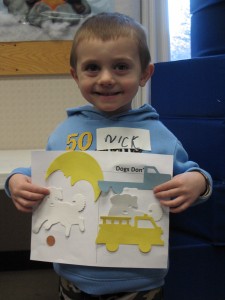Potty Animals!
 It’s time to potty! If you work with or have young children, you need Hope Vestergaard’s book “Potty Animals: What to Know When You’ve Gotta Go!”, illustrated by Valeria Petrone. One of the essential literacy skills kids need to become readers is “print motivation”. There has to be a reason and a desire to read, and if you give a kindergartner a book about going to the bathroom, that kid will want to read it! Not only is “Potty Animals” laugh-out-loud funny, it teaches (in rhyme) some very important life lessons like “Knock first!”, “Don’t wait too long!” and “Never forget to wipe!” This book should be read to every preschooler and kindergartner, and even a few forgetful older kids, too. After reading this book to your class, choose together the rules you want to put on a classroom poster – perfect to hang on the door if your bathroom is connected to your classroom! Potty on!
It’s time to potty! If you work with or have young children, you need Hope Vestergaard’s book “Potty Animals: What to Know When You’ve Gotta Go!”, illustrated by Valeria Petrone. One of the essential literacy skills kids need to become readers is “print motivation”. There has to be a reason and a desire to read, and if you give a kindergartner a book about going to the bathroom, that kid will want to read it! Not only is “Potty Animals” laugh-out-loud funny, it teaches (in rhyme) some very important life lessons like “Knock first!”, “Don’t wait too long!” and “Never forget to wipe!” This book should be read to every preschooler and kindergartner, and even a few forgetful older kids, too. After reading this book to your class, choose together the rules you want to put on a classroom poster – perfect to hang on the door if your bathroom is connected to your classroom! Potty on!
Dogs Don’t Brush Their Teeth
 Dogs Don’t Brush Their Teeth by Diane deGroat and Shelley Rotner is the perfect beginning reader book. The text on each page is simple: “Dogs do” or “Dogs don’t”. The pictures are photos that have been digitally manipulated to show what dogs do (like howl at the moon) and what dogs don’t do (like play an electric guitar in a rock band). Your little ones will be howling with laughter over the funny photos, and with the simple words, they’ll be successful readers the first time they pick the book up.
Dogs Don’t Brush Their Teeth by Diane deGroat and Shelley Rotner is the perfect beginning reader book. The text on each page is simple: “Dogs do” or “Dogs don’t”. The pictures are photos that have been digitally manipulated to show what dogs do (like howl at the moon) and what dogs don’t do (like play an electric guitar in a rock band). Your little ones will be howling with laughter over the funny photos, and with the simple words, they’ll be successful readers the first time they pick the book up.
We extended this book in two different ways. With our younger listeners, we had them decorate dog masks and put them on. Then we asked them to show us with their bodies what a dog can do (like nudge a ball on the floor) and what a dog can’t do (like toss and catch the ball in their hands). For a writing activity, students glued die-cuts of dogs and other objects and wrote or dictated sentences in a simple chart to show “Dogs Do” and “Dogs Don’t”. Nature Smart animal lovers and your Body Smart movers-and-shakers will love this book!
Read More“One Boy”
 With cool cut-outs on the pages, One Boy by Laura Vaccaro Seeger shows how one word can be found within another word. This counting book starts with the words “One boy” (who we see through a cut-out square on the next page.) Turn the page, and the square hole is now aligned over the word “one” to show that it’s part of the word “alone”. I made index cards of each word in the word pairs where one word shows through to be part of the other word (room and brooms, etc.) After reading One Boy to kindergartners, I gave each student a card with a word and asked them to find their “word building buddy”. Even students who were still working on letter identification could hold a card next to another to see how the letter shapes matched up. Once students had found their word building buddy, we displayed the cards next to each other and asked for a class vote of thumbs up or down on whether or not a match had been made. A counting book that also helps teach print awareness? One Boy is one good book!
With cool cut-outs on the pages, One Boy by Laura Vaccaro Seeger shows how one word can be found within another word. This counting book starts with the words “One boy” (who we see through a cut-out square on the next page.) Turn the page, and the square hole is now aligned over the word “one” to show that it’s part of the word “alone”. I made index cards of each word in the word pairs where one word shows through to be part of the other word (room and brooms, etc.) After reading One Boy to kindergartners, I gave each student a card with a word and asked them to find their “word building buddy”. Even students who were still working on letter identification could hold a card next to another to see how the letter shapes matched up. Once students had found their word building buddy, we displayed the cards next to each other and asked for a class vote of thumbs up or down on whether or not a match had been made. A counting book that also helps teach print awareness? One Boy is one good book!
Big Chickens
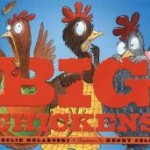 These chickens really are big chickens – they’re afraid of everything. When a wolf sneaks into the farmyard, they tumble out into the wide, scary world.
These chickens really are big chickens – they’re afraid of everything. When a wolf sneaks into the farmyard, they tumble out into the wide, scary world.
“‘I’m afraid to go home,’ said one chicken.
‘Ohh….’ said the others.
‘Me too.’
‘Me three.’
‘Me four.'”
But somehow, these chickens squawk, squirm, squeak, and squeal their way on some big adventures and find out that they are indeed big chickens – big, brave chickens. The language here is so rich that it’s perfect for building phonological awareness, and the art is a hoot.
After reading the book, sing with your listeners “If you’re a big chicken and you know it” and act out the scenes of the story: walk in the woods, jump in the ditch, bump into cows, etc. It’ll help your Body Smart kids to move their bodies as they retell the story, and everyone will be chiming in “Me too!” “Me three!” “Me four!”
Leslie Helakoski and Henry Cole also have Big Chickens Fly the Coop and Big Chickens Go to Town, and all three books are guaranteed to crack little ones up!
Read MoreCool “Jazz Baby”
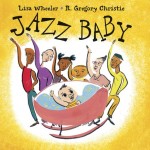 “Brother’s hands tap.
“Brother’s hands tap.
Sister’s hands snap.
Itty-bitty Baby’s hands clap-clap-clap!”
I don’t think it’s possible to read Jazz Baby by Lisa Wheeler and R. Gregory Christie aloud without bouncing a bit. This book, which earned the Geisel Honor Award, works on so many levels. Your Music Smart kids will be pulled into the the rhythm of the rhyme (and no one does rhyme as well as Lisa Wheeler). Your Body Smart kids can snap or tap along as you read. With all the “doo-wop-doo”s and “bop-bop-bop”s, this is a perfect springboard to introduce onomatopoeia. Brainstorm a list of sound words with your kids and have them find objects in the room (a pencil against an old coffee can) that make those sounds. Put on a jazz cd and let them experiment with keeping the beat. Take photos of your students making the sounds, print them off, and have the kids write the corresponding sound words to make a “Jazz Kids” class book. Cool, daddio!
Do Your Ears Hang Low?
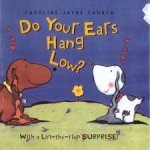 “Do Your Ears Hang Low?” by Caroline Jayne Church is a great choice if you’re looking for a preschool “print motivation” book. The art is big and bright for group sharing, the text is short and simple, and because it follows the classic song, you can sing-read this book. Books that can be sung will really connect with your Music Smart kids, and because lyrics are often easily memorized, song picture books support beginning readers as they learn to match spoken word to text. To maximize giggles during read-aloud and to guarantee your listeners will pick the book up after class is over, steal borrow this idea that I stole borrowed from ultra cool librarian, Ms. Claire, who stole borrowed it from reading guru Rob Reid. Yep, read the book with a pair of tights on your head, and act out the motions! Dignity is a small price to pay to motivate young readers.
“Do Your Ears Hang Low?” by Caroline Jayne Church is a great choice if you’re looking for a preschool “print motivation” book. The art is big and bright for group sharing, the text is short and simple, and because it follows the classic song, you can sing-read this book. Books that can be sung will really connect with your Music Smart kids, and because lyrics are often easily memorized, song picture books support beginning readers as they learn to match spoken word to text. To maximize giggles during read-aloud and to guarantee your listeners will pick the book up after class is over, steal borrow this idea that I stole borrowed from ultra cool librarian, Ms. Claire, who stole borrowed it from reading guru Rob Reid. Yep, read the book with a pair of tights on your head, and act out the motions! Dignity is a small price to pay to motivate young readers.
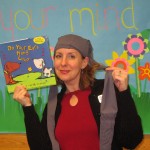
“The Pout-Pout Fish”
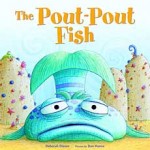 I can’t help but smile whenever I read the New York Times Bestseller “The Pout-Pout Fish” written by Deborah Diesen and illustrated by Dan Hanna. I can’t keep my listeners from grinning, either, or from chiming in on the refrain with this dreary-weary, permanently-pouting fish: “Blub. Blub. Blub.” With a little help from an unexpected friend, Mr. Fish does find a way to turn that frown upside-down. This rhyming story is great for building phonological awareness, and I love the finger rhyme that Debbie Diesen came up with to go with the book:
I can’t help but smile whenever I read the New York Times Bestseller “The Pout-Pout Fish” written by Deborah Diesen and illustrated by Dan Hanna. I can’t keep my listeners from grinning, either, or from chiming in on the refrain with this dreary-weary, permanently-pouting fish: “Blub. Blub. Blub.” With a little help from an unexpected friend, Mr. Fish does find a way to turn that frown upside-down. This rhyming story is great for building phonological awareness, and I love the finger rhyme that Debbie Diesen came up with to go with the book:
“Five little pouty fish swimming ’round the bed,
One blub-blubbed his grumpy head.
Mama called the doctor and the doctor said,
‘Read a good book and he’ll smile instead!'”
For more fun activities and free reproducibles, go to her website: deborahdiesen.com and be sure to check out “The Pout-Pout Fish in the Big-Big Dark”.
Read More



